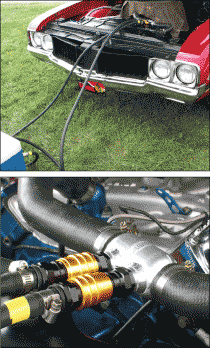Although former U.S. President Ronald Reagan may have regularly referenced the controversial concept of trickle-down economics, there have been other forms of the trickle-down effect that truly do benefit everyone. Racing technology constantly evolves as innovative new products or improvements to existing items are found to make more horsepower or increase a car’s traction, handling, or overall performance.
Many products, particularly those for racing engines, are initially developed for use in high-profile professional racing circles such as NASCAR Sprint Cup or NHRA Pro Stock. Eventually, these innovations trickle down to the sportsman racing classes and into mainstream street cars. CNC-ported cylinder heads and narrow, low tension piston rings are all good examples of products which originally could only be found on professional race cars, but are now common in sportsman racing classes as well.
Another example of a concept that has worked its way down to the grass roots level involves engine cooling. Sprint Cup and NHRA Pro Stock teams have achieved maximum performance by using large engine “chillers.” Chillers lower coolant temperatures (to as low as 50°F) prior to qualifying. Engine builders and racers alike agree that lower coolant temperatures result in more horsepower and lessen the chance of detonation.
Benefiting from lower coolant temperatures is not a new idea. Sportsman drag racers have been cooling their engines for decades in search of that extra couple of “hundredths”. Until now, they’ve been pouring large jugs of cold water through their cooling system prior to racing. However, this method is very labor intensive and doesn’t have quite the impact that ice water can provide.
High-end engine chillers typically use a built-in refrigeration unit in conjunction with a coolant storage tank that circulates cold water through the cooling system, however, these units cost several thousand dollars, and are out of the reach of a typical sportsman racer’s budget.
In recent years, more cost-effective engine chillers have become commercially available for between $700.00 and $1,500.00. Specifically aimed at the sportsman drag racing market, they have gained popularity in NHRA Stock, Super Stock, and select NMCA classes where “heads-up” type runs occur.
A typical chiller has a 10-15 gallon reservoir, usually mounted on a two-wheel cart for ease of transport. A built-in water pump, either 12- or 110-volt, circulates water from the race car’s cooling system through the cooler reservoir via pressure and return hoses. A one-way check valve with dry-break fittings is either installed in the car’s upper radiator hose, or connected to a specialized radiator cap with inlet and outlet fittings, to provide cooling system connections.
The reservoir is typically filled 1/3 full of water and the rest of the way with ice. The chillers hold enough ice/water mix to cool the engine between rounds and may be re-filled with ice as necessary.

Do-it-yourselfers on a tight budget can build an effective engine chiller at home using a large ice chest outfitted with a submersible 110V swimming pool pump. No need to buy a new pump; there are hundreds of used ones out there. Rubber garden hoses for both pressure and return can be plumbed through the upper sides of the ice chest, and dry break fittings, like those offered by Jiffy-Tite, may then be installed on the opposite ends of the hoses for quick, leak-free connections/disconnections.
A fabricated check valve, like the unit offered by C&R Racing (CRR70-11000 for 1-1/2″ dia. radiator hose), can then be installed in the radiator hose in the proper flow direction. Jiffy-Tite -8AN ORB (O-ring boss) valved fittings (JFT51108 socket and JFT52108 plug) are fitted to the C&R check valve. Valved -10AN push-lock fittings (JFT51510P socket and JFT52510P plug) are used on the chiller end, and they fit perfectly into a 5/8″ I.D. garden hose. Rubber garden hose is preferred rather than traditional nylon hose, which could distort when subjected to the high water temperatures common to racing engines. The unique design of the Jiffy-Tite fittings makes them interchangeable between all 5000-series fittings, even when AN sizing differs. The check valve has -8AN ORB provisions for inlet and outlet fittings, and are available to fit a wide variety of radiator hoses including 1-1/2″, 1-3/4″, -16AN, and -20AN.
A properly designed engine chiller can reduce water temperatures dramatically within just a few minutes. Some drag racers have experienced as much as 0.05-0.08 second reduction in elapsed times. It is recommended that the unit be used only after initial cooling to prevent thermal shock to engine components. Maximum performance benefits are achieved by using the chiller just before the next round, and running the engine as little as possible prior to racing.